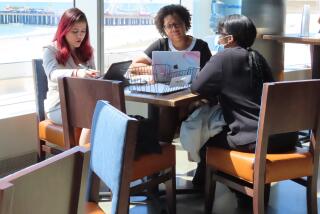What Works, What Doesn’t in Job Interview
- Share via
In a tight job market, the question of what to wear on a job interview becomes especially crucial to men and women. Clothes can make or break an applicant’s chances of landing a job.
“You won’t get the job based on your clothing, but you could lose it,” David Schwartz, co-owner of David Rickey & Co. men’s clothier in Costa Mesa. He has seen job applicants commit every kind of fashion gaffe.
There are those who have come through his door looking as if they’re headed for a black-tie dinner and those who look “like they’ve just been to a rummage sale.”
Some have worn suspenders with a belt--”an absolute no-no”--and some have packed themselves into suits that were two sizes too small.
“You don’t want to look stuffed into your suit,” he says.
Applicants get just one chance to make a first impression, he says, and once it’s made it tends to stick like lint on a dark suit.
“A person has to fight from then on to change it,” Schwartz says.
While opinions differ about the ideal interviewing outfit, most fashion experts agree that when going one-on-one with a prospective boss, dressing conservatively is key. The job interview is not the time to try out that wild retro tie.
“Go in an understated manner,” says Bjorn Sedleniek, owner of POSH menswear in Newport Center Fashion Island.
“In the last two years there’s been pretty significant changes in the classical clothing field,” he says. “Trendy Italian suits with flashier colors, including olive greens, are more acceptable. The silhouette of clothing has become more draped. The person interviewing might like this look, but I still maintain it’s safer to go with traditional clothing.”
Traditional does not mean out of date. Suit jackets, for example, have evolved so that wider shoulder points and a lower button stance have become the norm and pleated trousers are now standard issue, he says.
Sedleniek is quite specific when it comes to describing the ideal interviewing uniform. The suit should be medium to dark gray, either solid or with muted pin-stripes, the shirt should be white with a spread collar and the tie should be sedate.
“A navy blue suit would be overpowering,” he says. “It’s still a power suit and when you walk in it might appear you’re trying to upstage the person you’re talking to.”
One can substitute a pale blue shirt for a white one, he says, but shirts with stripes and contrasting collars are out.
An applicant’s tie, meanwhile, “should not pop out and look at the interviewer.”
“Neckwear in the last three years has really gone off the charts,” Sedleniek says. “You can select a tie that’s very current but not so wild as to take away from your overall appearance. No crazy abstracts or exploded paisleys.”
To complete the outfit, he suggests a pair of well-polished slip-ons or lace-up shoes in black or cordovan.
“There’s a saying that goes, ‘I don’t remember what he was wearing. All I remember was he was well-dressed,’ ” Sedleniek says. “The point is, you don’t want to be remembered for your clothes. All the interviewer is interested in is you.”
Women, too, should play it safe when interviewing, but for them the dress code is less defined.
Jeanette Anderson, manager of Episode in South Coast Plaza, Costa Mesa, suggests women seeking an executive position wear a black or navy suit with a simple under-piece such as a cream or black shell blouse.
“It should be a clean, professional look,” she says. “Keep it monotone. You don’t want to take attention away from you.”
Nor should the attention go to one’s legs. She advises keeping hemlines at a modest length.
“You really want to keep them at the knee or below the knee,” Anderson says.
Feet shouldn’t be overexposed either. She suggests a closed-toe shoe, without scuff marks or spiked heels. A simple pump with a one- to two-inch heel is best.
Jewelry should be scaled-down or not worn at all. Small pearls for the ears and neck are about as decked-out as one should get for the interview.
“You don’t want to be known as that woman who buys all that fashionable jewelry that’s distracting the office,” says Dianna Pfaff-Martin, owner of California Image Advisors in Newport Beach who counsels job applicants on their interview presentations.
She reviews clients’ interview wardrobes down to the smallest detail.
Women, she says, should wear no more than one ring per hand, and earrings should be no bigger than a button. Hair should not be full, and if it’s long it should be pulled back in a ponytail. Dark red nails and strong “Chanel” lips are out.
She says a common error for both men and women is to wear a watch that’s too casual for their outfit. She’s had clients wear plastic sports watches with their suits, for example.
“If all they have is a Swatch or or a plastic diver’s watch, don’t wear it,” Pfaff-Martin says. “But please be on time.”


